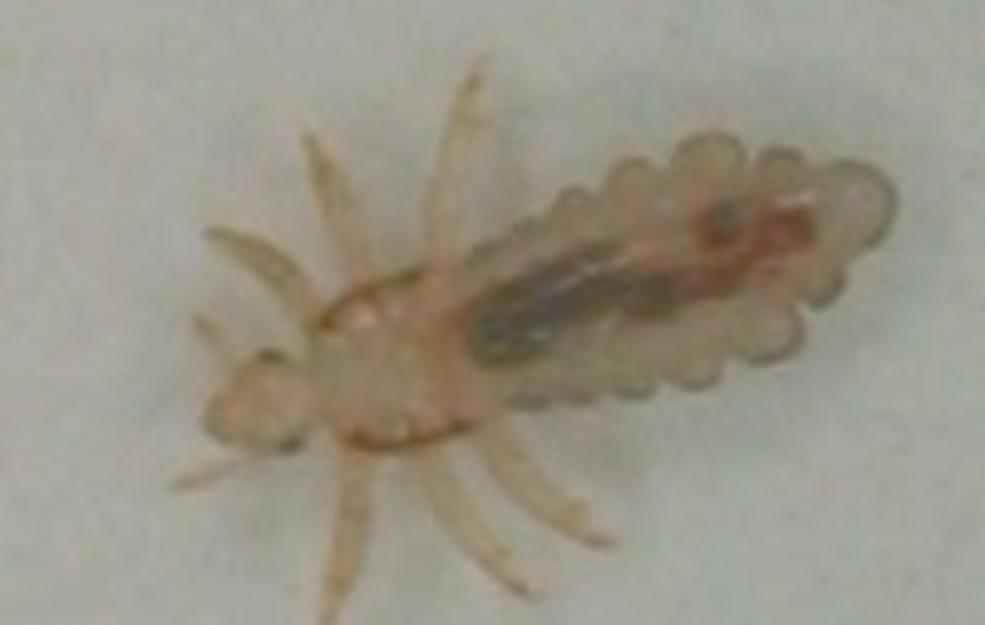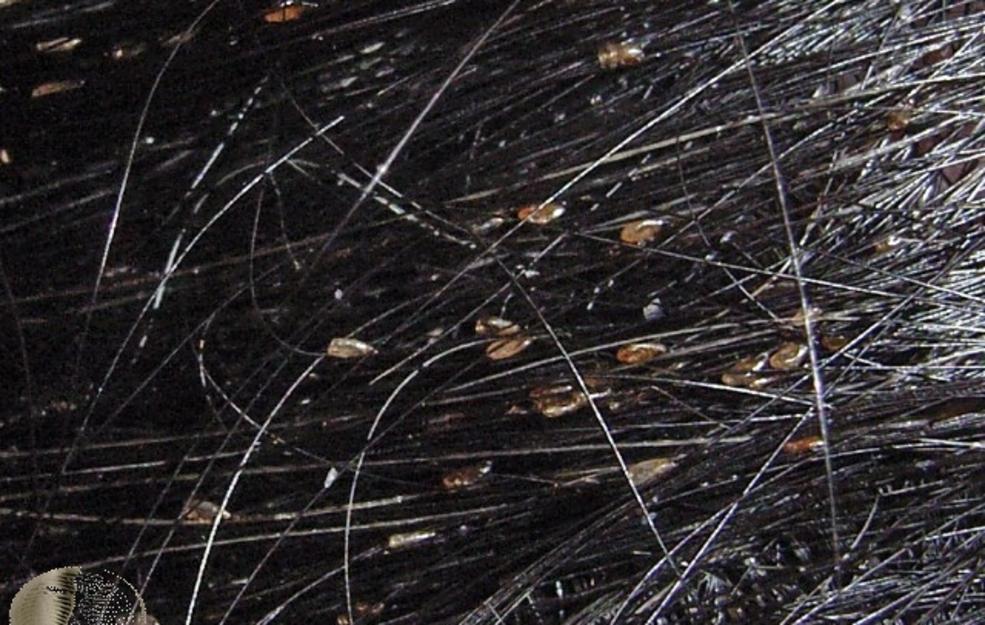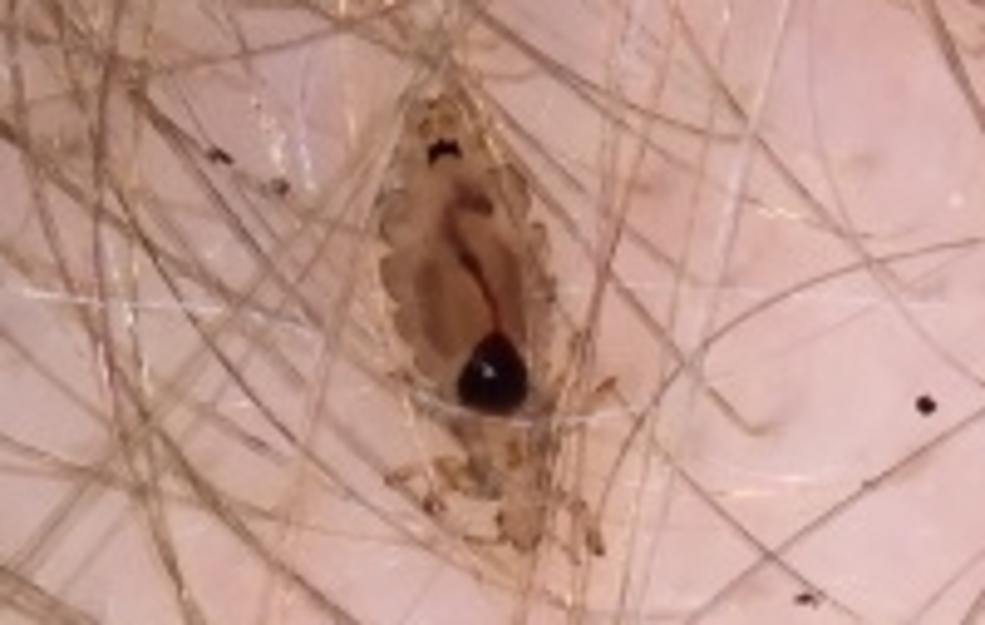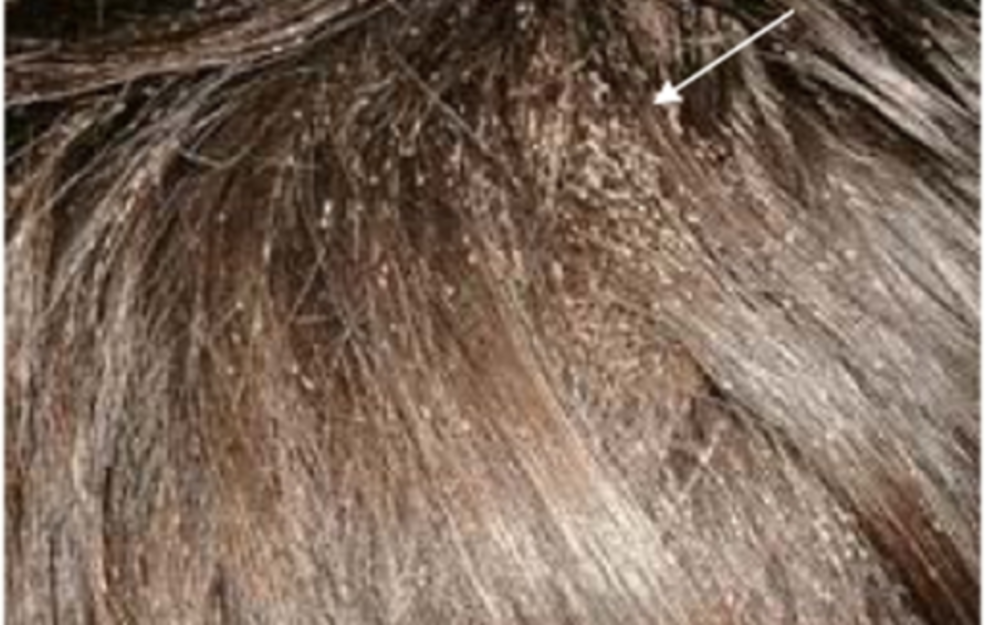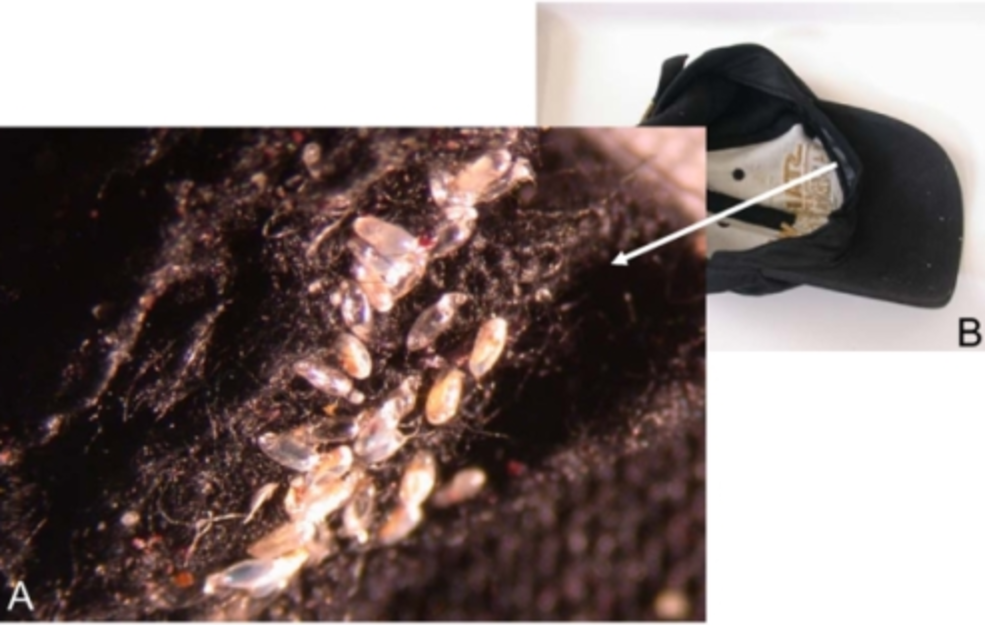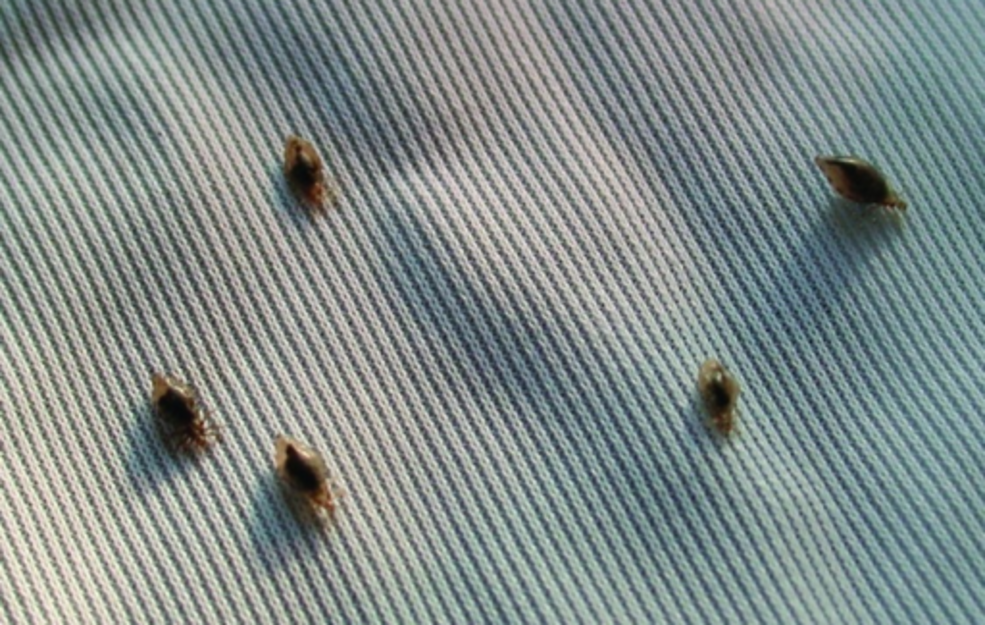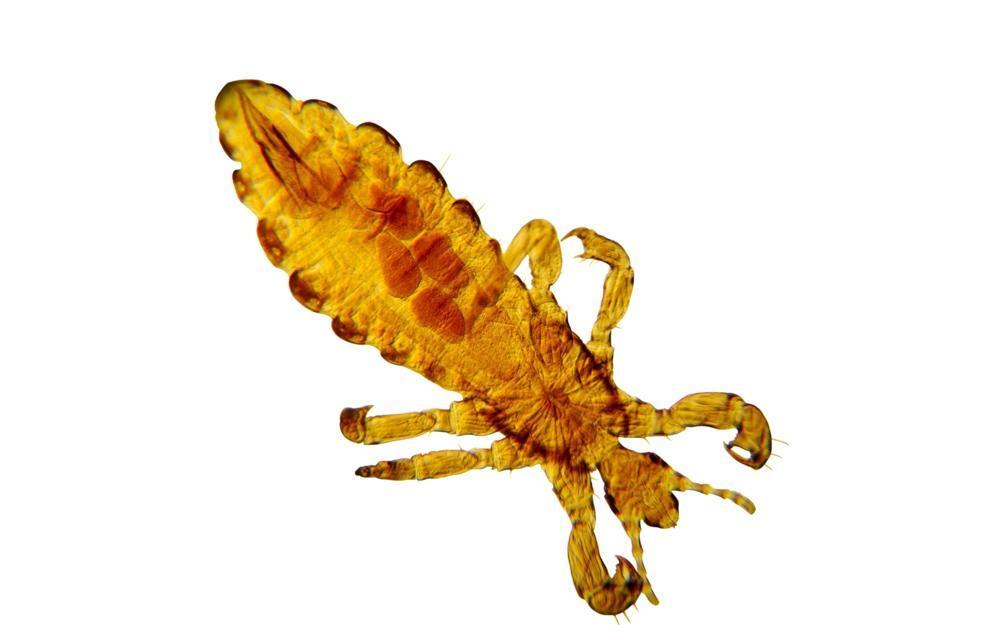What Do Head Lice Eggs Look Like?

Lice lay their eggs called nits, which are placed on the hair shaft. Nits look more like dandruff but they cannot simply be shaken out of the hair like dandruff. To get rid of lice eggs, you have to follow certain steps and make sure that their eggs or nits are completely removed from the hair.
Imagine your fright, when you notice a tiny speck on your children's head as you are getting them ready for school. Head lice are perhaps one of the parents' biggest fear, considering the rate at which they multiply. Having head lice makes your children to frequently itch or scratch their head. The most difficult part of dealing with head lice is how to completely get rid of them as they multiply very fast, are hard to find, and can easily be transferred from one person to another in no time. In other words, they are nothing but a menace.
Head lice are six-legged parasites that live on the human head. They are often grayish or tan in color, but some might become darker when they feed. Head lice tend to camouflage and take the color of your hair, making them difficult to spot with the naked eye. However, you can easily see them in regions behind the ears and at the back of the neck. Female lice lay several eggs every day and they are called "nits". These nits are oval in shape and might appear whitish, yellowish, or brownish.
Nits are empty white egg shells that are left after hatching. They look like dandruff but are firmly attached to your hair. Moreover, they can’t easily be brushed out.
How do nits or head lice eggs look like?
Adult lice have six legs and have a small size equal to that of a sesame seed. Their colors may vary, but usually, they range from beige, gray, and dark brown. Since they have camouflaging properties, lice will often have the same color as your hair. That is why it is somewhat difficult to see them with your naked eye. However, they can be easily spotted behind the ears and hair along the neck.
Female lice usually lay about ten minuscule eggs every day. These eggs or nits are oval and their color varies from white to brown.
The Life Cycle of a Louse
The female louse sticks her eggs on human hair shafts using a waterproof, sticky substance. This glue-like substance will ensure that the nits or eggs can’t be brushed, blown away, or washed, unlike dandruff that is often mistaken for nits.
The eggs are attached to the hair shafts, just close to the scalp, where the temperature is favorable for hatching. Nits usually hatch within nine days after they’re laid. Once hatching takes place, the shells remain attached to your hair shaft, moving far away from the scalp as your hair grows. Consequently, empty egg shells are often located farther from the scalp as compared to live nits.
Baby lice called "nymphs" are not much bigger than the nits and are more light-colored. Nine to twelve days later, they will become adults and begin to mate. The females produce the eggs and the cycle goes on.
What type of hair do head lice prefer?
Having lice on your head does not mean that you are not practicing proper hair hygiene. Lice do not favor dirt, but rather require human blood to survive. People normally get head lice by coming in contact with the head of an infected person. Lice are a very common problem and affect millions of people.
How will I know if my child has head lice?
It is quite difficult to identify head lice by just looking through your hair. If you think that you have head lice, it is advisable to comb your hair using a specialized lice detection comb. It is also highly recommended that you do this to your child’s hair regularly, like once every week. Using such comb might not always be necessary but it is beneficial if people you closely interact with have head lice, or if it is a recurring problem in your household.
Wet Combing Detection
This procedure will take 5-15 minutes, depending on the length and thickness of the hair being checked. To remove head lice through wet combing, do the following steps:
- Wash your hair or your child's hair using ordinary shampoo.
- Thoroughly rinse out the shampoo and apply plenty of hair conditioner.
- Carefully comb the hair to remove all tangles.
- Once the hair is fully disentangled, switch to a wet detection comb. Usually, you will have to choose a specialized fine-toothed comb.
- Check the detection comb for head lice after every stroke. A magnifying lens might help as well.
Head lice are common in young children, but older people can get them as well. Certain studies suggest that girls are more prone to having head lice than boys. Having head lice might be as a result of frequent head-to-head contact with other children as well as having a long hair, which provides the necessary warmth and darkness that they need.
What causes a head lice infestation?
Head lice often trigger an infection of the scalp. The most common problem that occurs due to a head lice infestation is the problem of itching, which can get very severe in some cases. Although having a head lice infestation is not a very serious medical condition, in some countries like Africa, an infestation of head lice can trigger a few diseases.
It is a known fact that head lice can easily spread through direct contact with the infected person’s hair. In schools, children often fall prey to a head lice infestation since they are not aware and are not able to prevent the transmission. It is a common misconception among people who believe that a person can get head lice due to poor hair hygiene. Head lice cannot be acquired from animals and pets such as cats and dogs. In fact, head lice are completely different from ticks, which is a confusion most people have. Head lice can only feed on human blood, thereby finding their hideout in human hair. In case head lice do not find a human head to feed on, they die within three days.
Natural Remedies to Get Rid of Head Lice
Getting rid of head lice is nothing less than a nightmare. In fact, in the case of children, parents are skeptical of using medicinal shampoos and other chemicals to wash off head lice, as it always has a risk of getting into their children's eyes and causing yet another problem. Thankfully, there are some natural remedies that can help you get rid of the toughest head lice, and without any side effects or pain. Some of the tried and tested remedies include:
1) Garlic
This is a one-stop remedy for most problems known to mankind, including a head lice infestation. The fragrance of garlic is too strong and can suffocate the most stubborn lice. It also helps in killing them. You can grind a few cloves of garlic and apply the paste on your scalp. Leave it for about an hour or so before washing your scalp and hair with warm water.
2) Baby Oil
This is yet another easy remedy to control a head lice infestation. Apply a liberal amount of baby oil on your child's hair. Let it stay for an hour or so. The head lice will generally become unconscious due to suffocation caused by the oil. Applying baby oil also helps you to easily filter head lice on the comb. Repeat this process for three to four days, until no traces of lice or eggs are found.
3) Tea Tree Oil
Tea tree essential oil is a natural remedy for a number of pest problems including head lice. Combine tea tree oil with some coconut oil and about an ounce of any natural shampoo. Apply this mixture well on your hair and cover it. Let the mixture act upon the lice, which should take about an hour or two before you wash it off well with lukewarm water. Avoid applying tea tree oil directly onto the head scalp, as it could cause irritation or burning. Always dilute it with a carrier oil.
4) Coconut Oil
Coconut oil is highly viscous, which immobilizes head lice preventing its multiplication and free movement. Apply coconut oil liberally over the hair and scalp and cover your hair with a shower cap to allow the oil to seep in. If possible, let the oil sink in overnight. The next morning, comb the hair and then shampoo thoroughly.
5) White Vinegar
White vinegar is yet another natural and inexpensive way of getting rid of head lice. White vinegar contains an essential compound called acetic acid, which can completely destroy head lice. Vinegar is also an excellent cleanser for the hair, and hence, will not harm your hair in any way.
6) Sesame Seed Oil
Sesame seed oil is not only a great nourishment to achieve a healthy hair, but it also has certain vital properties that make it an effective remedy in controlling head lice infestations. Create a mix of essential oils such as sesame oil, neem oil, tea tree oil, eucalyptus oil, and rosemary oil. Apply the mixture of essential oils on your hair. Cover your hair with a shower cap or a towel and leave it on overnight. Wash your hair thoroughly on the next day.
When should you seek medical advice for head lice?
In most cases, a head lice infestation does not necessarily require a medical intervention. However, there are some instances when the head lice cannot be eradicated by only using home remedies. You may need to consult a doctor for a head lice treatment, particularly when you have the following symptoms:
- If you experience inflammation, pain, and redness in your scalp and skin.
- If all the home treatments have failed, and you don't see any improvements from OTC medications.
- In cases when lice are suspected as a result of a sexually transmitted disease, especially when they are found in the pubic area.
To get rid of nits or lice eggs, you have to make use of a medicated shampoo along with a fine-toothed comb. It helps in removing the nits from the hair.
The following are steps to be taken to effectively get rid of the nits:
Step 1: Confirm the Movement of Lice.
It is not advisable to make use of lice shampoo if the bugs are not present in the hair. First, confirm the presence of lice in the hair before acting against them. One should heed advice from health professionals or from experienced individuals.
Step 2: Make use of topical medications, which can kill lice and nits.
The topical medication is a type of shampoo in the form of lotions. It can be used to effectively kill lice and nits. One should follow the rules given on the bottle for proper application.
Step 3: Use a comb that has strong and fine bristles to remove the nits.
Just applying your hair with medicated shampoos won't completely remove lice and nits. For this reason, you need to use a fine-tooth comb and run it through your hair to effectively get rid of lice and nits.
Q. How important it is to check your head and how often should it be done?
A. It is very important to regularly check your head on a daily basis to help prevent lice infestations. An early detection of lice infestation is better to avoid spreading the infestation to others.
Q. What will you look for during a head check?
A. While checking the head for possible nits and lice, many times, you will find various things, especially in children. Head lice are six-legged parasites, which often come in tan or darker colors. Nits are oval in shape they appear white to brown in color. Regular hair combing not only keeps the head clean of lice and nits, but it also helps in removing unwanted particles, too.
Q. How to maintain your long hair and how to prevent lice?
A. Regularly wash and clean your hair. Aside from regular hair washing, long hair should be kept in a hairdo such a bun, braid, or gathered ponytail. A lice infestation should be carefully handled. Lice tend to spread very easily from one head to another. However, there are available OTC treatments for lice infestations.
Q. How many treatments are needed to completely get rid of lice and nits?
A. The treatments for lice are not fixed since they usually depend on the severity of the infestation. Sometimes, lice can get wiped out within one or two treatments and in some other cases, it needs more treatments. Lice treatment includes using medicated shampoos or lotions while taking a bath. Also, the hair needs to be comb repeatedly during the day to detect remaining lice and nits. The entire treatment process may take 1-2 weeks.
Q. What if I see more adult lice or an increase in the number of nits during the treatment cycle?
A. If adult lice are seen during the treatment cycle, then it is clear that the treatment is not very effective. Most lice get wiped in the first treatment, but it still depends on the severity of the infestation. You have to choose another method of treatment or use a more effective medicated shampoo to get rid of stubborn lice.
Q. Is it required to comb between the treatments?
A. It is not necessary to comb while applying treatment. Most lice are weakened when they get in contact with the treatment.


